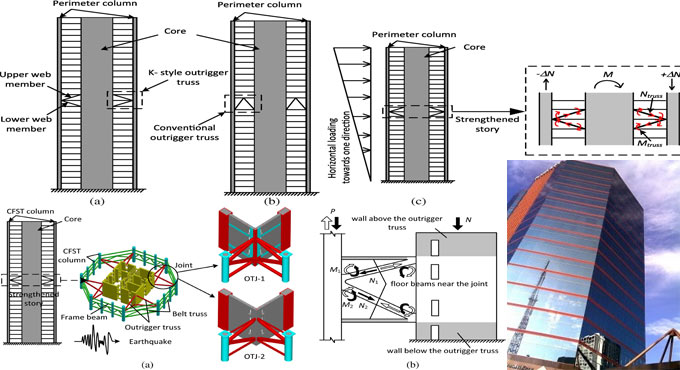
Benefits of outrigger and belt truss system for a building
The outrigger and belt truss system refers to the most recognized method for withstanding lateral loads. Under this method, the external columns are attached with the central core wall with very rigid outriggers and belt truss at one or more levels. The belt truss is attached with the external column of building whereas the outriggers retain them with main or central shear wall. The purpose of this method is to minimize hindered space compared to the traditional method.
The floor space does not contain any columns and remains among the core and the external columns, as a consequence, the functional efficiency of the building is raised. Exterior columns restricted the core wall from free rotation via outrigger arms, outrigger and belt trusses, connect planar vertical trusses and exterior frame columns. With outrigger system, the structural materials can be applied effectively by utilizing the axial strength and stiffness of exterior columns.
Collar joints: In this type of joint, the ends of sewer are plain.
The inclusion of an outrigger that attaches the two elements together produces a rigid component to withstand the overturning forces mutually. If an outrigger-braced building deflects under wind or seismic load, the outrigger that relates the core wall and the exterior columns, transforms the entire system to function as a unit for defying the lateral load.
Types Of Outrigger Truss System
Based on the connectivity of core to exterior columns, this system is segregated as follow :
? Conventional Outrigger Concept
? Virtual Outrigger Concept
Traditional Outrigger Concept: In the traditional outrigger concept, the outrigger trusses or girders are attached directly to shear walls or braced frames at the core and to columns situated outboard of the core. Generally (but not necessarily), the columns are located on the outside edges of the building.
Virtual Outrigger Concept: In the ?virtual? outrigger, the equivalent transfer of overturning from the core to elements outboard of the core is obtained, but devoid of a direct connection among the outrigger trusses and the core. The fundamental concept behind the virtual outrigger method is to apply floor diaphragms, which are generally very rigid and strong in their own plane.
Benefits of applying Outrigger & Belt truss system
1. No trusses exist in the space among the core and the building exterior.
2. There are little restrictions on the position of exterior columns. The requirement for finding out the large exterior columns where they are directly involved with outrigger trusses, expansion from the core is discarded.
3. All exterior columns (not just particular designated outrigger columns) contribute in countering overturning moment.
4. Difficult connection of the outrigger trusses to the core is removed.
5. Core overturning moments are minimized through the reverse moment employed to the core at each outrigger connection.
6. Exterior framing comprises of simple beam and column framing devoid of the need for rigid-frame-type connection, consequently curtailing the entire cost.
7. Uplift and net tension forces are minimized or removed devoid of the column and foundation system.
To get more information, go through the following link civildigital.com


